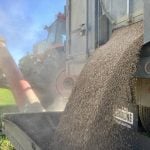This year’s push for a corn stover-processing facility to be built somewhere in southern Ontario isn’t exactly new. Many similar proposals have been voiced in the past decade. This time, though, there’s a difference.
What sets this venture apart is that the combination of economic benefits for the region and agronomic benefits for growers may be enough to justify the construction of a biorefinery to convert a quarter of a million large square bales of corn stover into a variety of products.
One key indicator of that potential is the sheer number of companies and organizations showing interest in this particular proposal. During a cornstalk-harvesting and -baling demonstration, held during three days early in November, farmers, dealers and industry representatives worked over the economic forecasts and infrastructure requirements for such a facility.
Read Also

Using forage crops to fight flooding
Glacier FarmMedia – Planting more forage would be valuable for flood control, and new research has numbers to back that up….
At least 20 different businesses, farm groups and public-sector participants are or have been involved in this venture, with BioIndustrial Innovation Canada, the Ontario Federation of Agriculture and La Coop fédérée leading the way.
The proceedings for each day included morning presentations in Inwood, Ont., southeast of Sarnia, followed by afternoon field demonstrations at the farm of Don and Anne McGugan, just outside of Alvinston. In the field, Advantage Farm Equipment and AGCO provided the Massey Ferguson/Hesston baling equipment, Hiniker had a windrow shredder and Stinger supplied the bale stacker. Agris Co-operative, the Agromart Group, Wanstead Farmers Co-operative, Bioindustrial Innovation Canada and IGPC Ethanol were also part of each day’s proceedings.
The morning presentations focused on the plant’s feasibility, with Lambton County figuring prominently in the proposed facility. The proximity to Sarnia is certainly an advantage from an infrastructure standpoint. The city, known across Canada as “the Petrochemical Valley” is in the midst of a rebranding to “the Biochemical Valley,” and there’s the admitted allure of repurposing existing infrastructure for this particular biorefinery.
But the logistics of 250,000 bales of corn stover may require siting the refinery farther east of Sarnia. In simple terms, to be economically viable, the venture needs to operate 24 hours a day, 365 days a year, pulling those 250,000 bales from within a roughly 100-km radius.
If the processing plant is near the U.S. border at Sarnia, it would mean a third of that radius would get lost in southern Lake Huron.
But that’s part of the ongoing feasibility study by those companies interested in the potential this plant could derive.
While those calculations are getting made, however, the call for action is getting urgent, modelled on a similar plant that’s now operating in Nevada, Iowa, a town of 6,700.
As Lambton County farmer and current OFA vice-president Don McCabe pointed out during his presentation, if a small town in Iowa can make this work, there’s no reason why Lambton County — or southern Ontario — can’t and shouldn’t be able to do the same.
“But this whole thing has to work in advance for the farm community to move ahead,” says McCabe, who farms near Inwood. “There will always be some people who do not see the need for this. First and foremost, as a farmer, this is about residue management, so you need to know what your soils are doing now before you embark on this. Then you need to make sure you have a diversified crop rotation or corn, soybeans and wheat in this system.”
The agronomic benefits of this processing plant can’t be overlooked, either. Yields are trending up, as are planting densities — already well above 32,000 in most places in southern Ontario, with some above 38,000. Expecting no-till or reduced-till systems to break down corn stover in time for a subsequent soybean crop is proving unrealistic.
McCabe points to the 2014 harvest as an example of how weather affects field operations, including the potential for rutting of fields, likely leading to increased spring tillage.
Economic benefits tied to the soil, too
In addition to removing the stover, there’s the economics attached to the potential for improved soil health. According to research conducted in Iowa, farmers participating in corn cellulosic ethanol projects have gained a net profit of $36 per acre including a 5.2 bu./ac. yield advantage with the stover collection. The Iowa results also equated a 150 bu./ac. grain corn yield with the collection of one tonne of stover per acre (or two tonnes per acre with a 180 bu./ac. yield). Tillage is also reduced with less residue to be managed, and researchers in Iowa observed that less residue on the field means warmer soils and an earlier starting date the following spring.
Other quality parameters include longer crop rotations (corn, soybeans and wheat), the use of cover crops, and improved protection against erosion — all of which should help maintain or increase soil organic matter.
In Iowa, bales ideally are at 20 to 25 per cent moisture (they can run as high as 35 per cent) and large square or round bales are accepted. In terms of nutrient removal, it’s important to continue to monitor nutrient replacement with stock removal. Potassium and some micronutrients will need to be replaced, although spring harvest of the stover can minimize nutrient removal.
The time to act
Although a facility for southern Ontario is still several years away, McCabe is a staunch believer in the need for Ontario agriculture to act now. A “wait-and-see” approach leaves too much to chance, he says.
One positive development is the recent formation of the Cellulosic Sugar Producers’ Co-operative. The co-operative has adopted a strategy of dealing with a group of farmers that can and will meet the agronomic and qualitative specifications of this biorefinery.
Part of that economic outlook also includes a change in attitudes on the farm. During the presentations in November, McCabe didn’t mince words about avoiding the notion of being “price takers,” as is the norm in farming. Instead, he said, farmers need to get on board with building a sustainable new market.
As time goes on, the price of the feedstock is likely to go down, while the value of the products produced at the other end will go up. So it’s the return on equity derived from the processing plant that will actually drive greater utilization and product discovery.
It’s much the same process as the Greenfield ethanol plant in Chatham-Kent. It started producing ethanol as a primary product, then dry distillers grain, then carbon dioxide, and then heat for an attached greenhouse operation.
This corn stover-bioprocessing plant is expected to do the same. First, it will derive sugars including glucose, fructose, xylose, arabinose, lactose, sucrose and starch from the stover, in the form of cellulose and hemi-cellulose components. From there, those sugars could be used to produce what are known as C4, C5 and C6 “building blocks” such as sorbitol, levulinic and succinic acid, with a host of customers willing to pay for consistent supplies and quality of those products.
“It’s similar to an elevator buying corn,” says McCabe. “When it takes in corn, it doesn’t matter who buys it later, just as long as you do find buyers. That’s what’s important. We want to maximize our opportunities to get back into the marketplace and we want to do it with these biochemicals or biocomposite opportunities because that’s a higher return on investment than fuels.”
The road ahead
So together with Cellulosic Sugar Producers’ Co-operative, there are plenty of other processes that are underway, with a possible start date of 2018. But as James Lee, director of commercialization for BioIndustrial Innovation Canada says, there are many uncertainties that must still be investigated. For instance, the pace with which technologies are discovered and implemented may enable an earlier date. Or, there may be something else that delays it.
“We still have to evaluate the full-scale economics,” says Lee, adding that all eyes are on the three large-scale projects now in operation in the U.S., including the Abengoa plant in Hugoton, Kansas, the POET-DSM project in Emmetsburg, Iowa, and the DuPont project in Nevada, Iowa. “Those are multi-hundreds of million-dollar projects, where they take stover and turn it into corn ethanol. I anticipate it being that magnitude a project, where you need scale to make it economic.”
Lee echoes McCabe’s comments about adding value to what is merely considered residue. But he cautions that while this product starts at the farm, it finishes with consumers buying the products made from materials off the farm, and all at a higher value to those consumers.
Right now, Lee and McCabe and others involved in the project are moving beyond feasibility studies completed in 2013 and the followup study on the aggregation of the stover and potential storage issues, conducted by the OFA and La Coop fédérée. The first step was funded by BioIndustrial Innovation Canada, with help from Agriculture and Agri-Food Canada and the Agricultural Adaptation Council. The second study received funding from AAFC and BioIndustrial Innovation Canada. Money from AAFC was provided from the Program of Energy Research and Development (PERD), operated by Natural Resources Canada.
“The third phase involves selecting the technology to convert that biomass into higher-value products, starting with sugar,” says Lee. He borrows a term from the petrochemical industry — crude oil crack or gasoline crack — and says their aim is to push the value add. “What we’re trying to do is maximize the value of a biomass crack. That means getting the maximum value from the products made from all parts of the corn stover. Part of this is to find the right combination of technology that maximizes that value.”
Once this facility is up and running, and once it demonstrates it can be effective, Lee suggests it might be a first step towards establishing similar plants in Western Canada, with a similar opportunity for wheat straw as a feedstock. Or, given its western migration, a facility could be run on corn as well.
“It comes down to realizing who your customers are,” says Lee. “Our customers are here (in southern Ontario). Who are your suppliers? Our farmers are here. That’s two components and the third is whether you have the steel in the ground to connect the farmer to the customer.”
It’s worth noting that the feasibility study was carried out by Lynn Marchand and Randy Duffy of the University of Guelph-Ridgetown Campus in 2013. Financial and in-kind contributions were also made by Agriculture and Agri-Food Canada and the Agricultural Adaptation Council, Lanxess Energizing Chemistry, BioIndustrial Innovation Canada, BioAmber, Midori Renewables, Ontario Agri-Food Technologies, Agris Co-operative and the Grain Farmers of Ontario.
For further reading, you can download, Development of a Business Case for a Cornstalks to Bioprocessing Venture via the Ontario Federation of Agriculture website, or Top Value Added Chemicals from Biomass from the U.S. Department of Energy website.



















